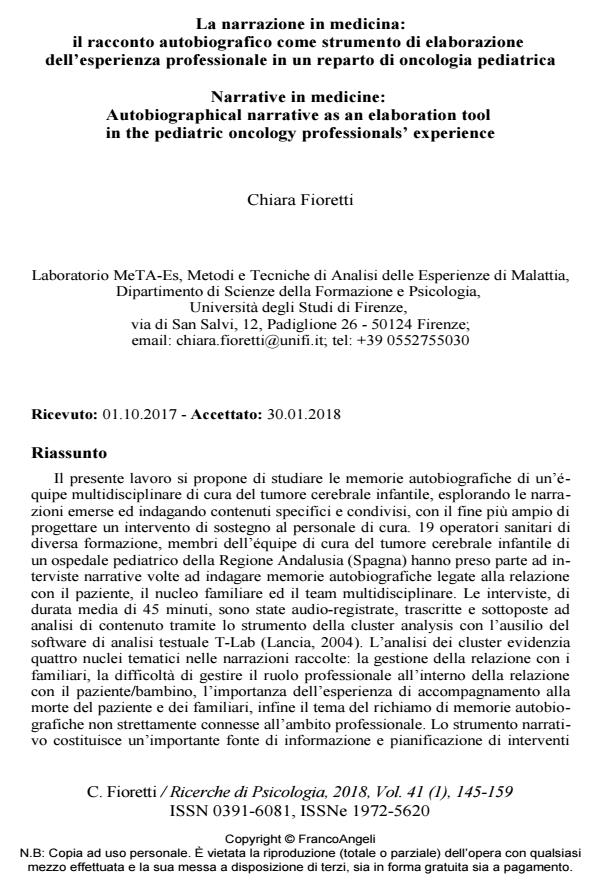Narrative in medicine: Autobiographical narrative as an elaboration tool in the pediatric oncology professionals’ experience
Journal title RICERCHE DI PSICOLOGIA
Author/s Chiara Fioretti
Publishing Year 2018 Issue 2018/1
Language Italian Pages 15 P. 145-159 File size 227 KB
DOI 10.3280/RIP2018-001011
DOI is like a bar code for intellectual property: to have more infomation
click here
Below, you can see the article first page
If you want to buy this article in PDF format, you can do it, following the instructions to buy download credits

FrancoAngeli is member of Publishers International Linking Association, Inc (PILA), a not-for-profit association which run the CrossRef service enabling links to and from online scholarly content.
The present study aims to explore autobiographical memories of a multidisci-plinary team dealing with pediatric brain tumors, exploring professionals’ narra-tives and investigating specific and shared contents, with the broader goal of pro-jecting a support intervention for the professional staff. 19 professionals members of the health staff caring for children with brain tumors took part to autobiograhical narratives aiming to explore their memories dealing with the relational experience with patients, their families and other members of the team. Interviews lasted 45 minutes and have been recorded, transcribed and analysed with the T-Lab software (Lancia, 2004). Cluster analysis has pointed out four topics in narratives: the management of relationships with families, the difficulty of maintaining the professional role in the relation with patients, dealing with death and disability in caring for children and personal memories not directly related with professional life. Autobiographical narrative is an important tool to collect information and to project interventions not only with patients but also with the professional staff. Furthermore, the present study helped researchers to identify problems and resources shared within the health staff in order to project an intervention focused on the empowerment of relational and clinical competences starting from collected narratives.
Keywords: Narrative, medicine, children brain tumors, professional health staff
- Anderson, R.E. (1999). Billions for defense: the pervasive nature of defensive medicine. Archives of Internal Medicine, 159(20), 2399-2402.
- Axia, V. (2004). Elementi di psiconcologia pediatrica. Roma: Carocci.
- Bardes, C.L. (2012). Defining “patient-centered medicine”. New England Journal of Medicine, 366(9), 782-783.
- Bruner, J. (1990). Acts of Meanings. Hardvard: Hardvard University Press.
- Charon, R. (2006). Narrative medicine: Honoring the stories of medicine. Oxford: Orford University Press.
- Collins, F.S., & Varmus, H. (2015). A new initiative on precision medicine. New England Journal of Medicine, 372(9), 793-795.
- Fioretti, C. (2015). Le parole di chi cura. In S. Smorti & G. Donzelli (Eds). La Medicina Narrativa in pediatria (pp. 157-170). Firenze: SEID.
- Fioretti, C., Lauro-Grotto, R., Tringali, D., Padilla Muñoz, E.M., & Papini, M. (2014). Caring for children with brain tumors in an oncology ward: a phenomenologic-hermeneutic study. Journal of pediatric and neonatal individualized medicine, 3(1), 1-12. DOI: 10.7363/030112
- Fioretti, C., & Smorti, A. (2014). Improving doctor-patient communication through an autobiographical narrative theory. Communication & Medicine, 11(3), 275.
- Fioretti, C., & Smorti, A. (2015). How emotional content of memories changes in narrative. Narrative Inquire, 25(1), 37-56.
- Fioretti, C., & Smorti, A. (2017). Narrating positive versus negative memories of illness: Does narrating influence the availability and the emotional involvement of memories of illness? European Journal of Cancer Care, 23(4), e12524.
- Greenhalgh, T., & Hurwitz, B. (1999). Narrative based medicine: Why study narrative?. BMJ: British Medical Journal, 318(7175), 48.
- Hamburg, M.A., & Collins, F.S. (2010). The path to personalized medicine. New England Journal of Medicine, 363, 301-304.
- Lancia, F. (2004). Strumenti per l’analisi dei testi. Introduzione all’uso di T-LAB.
- Kleinman, A. (1988). The illness narratives: Suffering, healing, and the human condition. New York: Basic books.
- McAdams, D.P. (2001). The psychology of life stories. Review of General Psychology, 5, 100-122. DOI: 10.1037//1089-2680.5.2.100
- Ninio, A., & Bruner, J. (1978). The achievement and antecedents of labelling. Journal of child language, 5(1), 1-15. DOI: 10.1017/S0305000900001896
- Pasupathi, M. (2001). The social construction of the personal past and its implications for adult development. Psychological Bulletin, 127(5), 651–72. DOI: 10.1037/0033-2909.127.5.651
- Sackett, D.L., Rosenberg, W.M., Gray, J.M., Haynes, R.B., & Richardson, W.S. (1996). Evidence based medicine: what it is and what it isn't. British Medical Journal, 312,71.
- Smorti, A. (2011) Autobiographical memory and autobiographical narrative. Which is the relationship? Narrative inquire, 21(2), 303-310.
- Smorti, A., Cappelli, F., Zarantonello, R., Tani, F., & Gensini, G.F. (2014). Medical error and systems of signaling: conceptual and linguistic definition. Internal and Emergency Medicine, 9(6), 681-688.
Chiara Fioretti, La narrazione in medicina: il racconto autobiografico come strumento di elaborazione dell’esperienza professionale in un reparto di oncologia pediatrica in "RICERCHE DI PSICOLOGIA " 1/2018, pp 145-159, DOI: 10.3280/RIP2018-001011